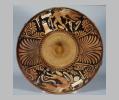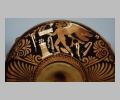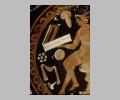| Collection: | Toledo Museum of Art |
| Summary: | Tondo: Eros seated on a rock |
| Ware: | Apulian Red Figure |
| Painter: | Attributed to the Menzies Group |
| Date: | ca. 375 BC - ca. 350 BC |
| Dimensions: | H. to highest knob 0.187 m., h. to rim 0.12 m., d. rim 0.403 m., d. foot 0.15 m. |
| Shape: | Knobbed patera |
| Period: | Late Classical |
Decoration Description:
Tondo: Eros seated on a rock. Facing left, Eros rests on a stool-high rock, leaning on his left hand, with his wings erect behind him. In his right hand he holds an open box, its lid's underside decorated. Hanging from the fingers of his right hand is a ball wrapped with ribbons. He is wearing a necklace of white beads which extends across his chest, under his left arm and over his right shoulder, as well as encircling his neck. Two more strings of beads are fit onto his left thigh. In the field surrounding him are hanging a bunch of grapes, a rosette, a sash, a fillet, a phiale, flowers and leaves. A fillet appears in the exergue.
Around the tondo runs a band of left-facing waves, surrounded by a plain band and one of laurel leaves and berries. Each of the ridged, glazed vertical handles holds a mushroom-shaped knob in the middle. Two identical knobs flank each handle. The upper surface of the rim is reserved and reddened; its outer edge has the same finish with a band of strokes over it.
Added white is abundant in the tondo, in some cases with an ochre wash as well. Details of Eros's wings, his hair fillet, dots on the grape bunch and attached tendrils, the exterior of the box and its lid, the rosette, the ribbons binding the ball, the fillet and sash, the fillet in the exergue, the phiale, details of Eros's rock, and the groundline under him all show added white. The laurel leaves and berries surrounding the tondo are also in added white, as is the decoration on each knob, a rosette with petals radiating from a circle.
Side A: Eros striding toward an altar. Eros walks left up to an altar with a rosette on top. In his right hand he is holding an open box whose lid interior, like that in the tondo, is decorated. In his left hand is a wreath with a fillet hanging from it. Eros is wearing a fillet, beads around his neck, chest, and left thigh, and bracelets around his forearms and calves. In the field surrounding him are two more fillets, another wreath and fillet, a phiale, an ivy leaf and a rosette.
Added white, in certain cases under ochre, appears in Eros's wings, fillet, jewelry and feet, the right side of the ivy leaf and its tendrils, the sides and lid of the box, dots on both wreaths, the fillets, the rosettes, the altar and the phiale, and three dots of a groundline.
Side B: Eros flying. Holding an open box in his right hand, Eros flies left. Like the other boxes, this one's lid is decorated. As in the tondo, a ball wrapped in ribbons hangs from the fingers of his right hand, under the box. In his left hand Eros holds a fillet, and a sash is draped over his right forearm. Eros wears the same jewelry as on side A, except that he has no bracelet on his right arm. In the background are a phiale, three fillets, two rosettes, leaves, flowers and leafed branches with berries. Added white, in many places with dilute ochre wash, appears in the same details as for side A.
Below each handle sits a large palmette surrounded by floral motifs. Below the main panel a band of left-facing waves circles the bowl. Underneath this are two narrow lines and a wide band. A reserved reddened area shows the juncture of the bowl with its foot. The profiled foot itself is flaring and slipped. The undersurface is reserved.
Sources Used:
Other Bibliography:





